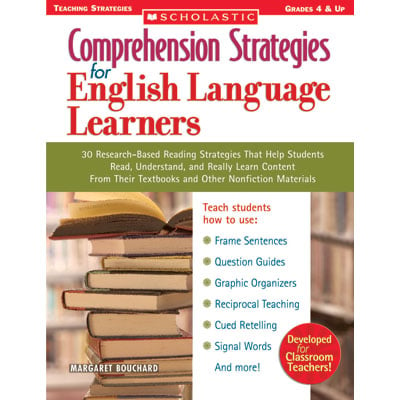Most people don’t realize that strategy plays an important role in teaching. It is important for a teacher to constantly assess his/her teaching strategy and seek out new ways to get students to learn. Effective teachers don’t settle for the same old strategy; an effective teacher strives to find new and innovative teaching practices all the time. As a language teacher, it’s important not to overlook the importance of teaching methodology and strategy. Knowing the material - in this case, the language –is not enough; you have to know how to teach the material.
For language teachers, improving a student’s reading comprehension poses its own set of specific difficulties. That’s where Comprehension Strategies for English Language Learners comes in handy.
"Effective teachers don’t settle for the same old strategy; an effective teacher strives to find new and innovative teaching practices all the time"
Author Margaret Bouchard has put together a great reference book for language teachers. The book takes some common teaching methods and applies them specifically to the subject of teaching English as a Second Language. The book starts with a basic introduction that explains the importance of focusing on reading comprehension when teaching English as a second language, points of consideration when deciding which strategy to implement and when, and language development and cultural adaptation.
From there, the book goes on to give the teacher strategies specifically for beginner language learners. This involves the use of illustrations and frame sentences. Each section is organized into three parts. First is the “purpose.” This explains why the strategy is used. Second, the book identifies the “Key Benefits for English Language Learners.” This section tells you what the learner will get out of using this strategy. Last, is the “Procedure.” This is a step-by-step example of how to use the learning strategy in the classroom. Following this is a worksheet which the teacher can use with his/her students in the classroom. All of these strategies are similar to a template. Though an example lesson is given, each can be reused multiple times with different content created or given by the teacher. This helps teachers with lesson planning and increases the books usability.

After beginners, the book progresses to various strategies that can be used with intermediate students. This includes: meta-cognitive strategies, cognitive strategies, and socio-affective strategies. These sections are all quite thorough, providing the teacher with many ways to effectively teach reading comprehension. In the “Metacognitive Strategies” section, there are seven specific strategies that one can implement in the classroom. With such a range of reading comprehension activities and methods, this book will help you to teach almost any student how to improve his/her reading comprehension. According to the needs of your students, you can make use of all or some of the reading comprehension strategies presented in the book.
Even if you have a teaching degree and already know these reading comprehension strategies, having them all in the same book is quite useful. Having the content tailored specifically to teaching English as a second language is also quite helpful. Realistically, the methodology presented in this book can be utilized by teachers of almost any language.




